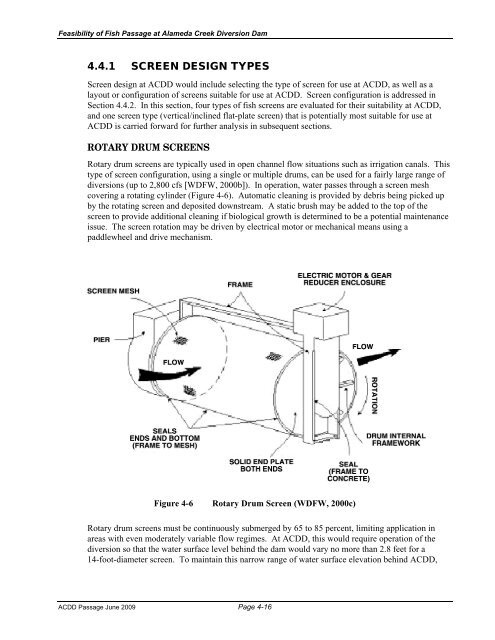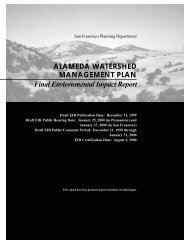Feasibility of Fish Passage at Alameda Creek Diversion Dam
Feasibility of Fish Passage at Alameda Creek Diversion Dam
Feasibility of Fish Passage at Alameda Creek Diversion Dam
You also want an ePaper? Increase the reach of your titles
YUMPU automatically turns print PDFs into web optimized ePapers that Google loves.
<strong>Feasibility</strong> <strong>of</strong> <strong>Fish</strong> <strong>Passage</strong> <strong>at</strong> <strong>Alameda</strong> <strong>Creek</strong> <strong>Diversion</strong> <strong>Dam</strong>4.4.1 SCREEN DESIGN TYPESScreen design <strong>at</strong> ACDD would include selecting the type <strong>of</strong> screen for use <strong>at</strong> ACDD, as well as alayout or configur<strong>at</strong>ion <strong>of</strong> screens suitable for use <strong>at</strong> ACDD. Screen configur<strong>at</strong>ion is addressed inSection 4.4.2. In this section, four types <strong>of</strong> fish screens are evalu<strong>at</strong>ed for their suitability <strong>at</strong> ACDD,and one screen type (vertical/inclined fl<strong>at</strong>-pl<strong>at</strong>e screen) th<strong>at</strong> is potentially most suitable for use <strong>at</strong>ACDD is carried forward for further analysis in subsequent sections.ROTARY DRUM SCREENSRotary drum screens are typically used in open channel flow situ<strong>at</strong>ions such as irrig<strong>at</strong>ion canals. Thistype <strong>of</strong> screen configur<strong>at</strong>ion, using a single or multiple drums, can be used for a fairly large range <strong>of</strong>diversions (up to 2,800 cfs [WDFW, 2000b]). In oper<strong>at</strong>ion, w<strong>at</strong>er passes through a screen meshcovering a rot<strong>at</strong>ing cylinder (Figure 4-6). Autom<strong>at</strong>ic cleaning is provided by debris being picked upby the rot<strong>at</strong>ing screen and deposited downstream. A st<strong>at</strong>ic brush may be added to the top <strong>of</strong> thescreen to provide additional cleaning if biological growth is determined to be a potential maintenanceissue. The screen rot<strong>at</strong>ion may be driven by electrical motor or mechanical means using apaddlewheel and drive mechanism.Figure 4-6 Rotary Drum Screen (WDFW, 2000c)Rotary drum screens must be continuously submerged by 65 to 85 percent, limiting applic<strong>at</strong>ion inareas with even moder<strong>at</strong>ely variable flow regimes. At ACDD, this would require oper<strong>at</strong>ion <strong>of</strong> thediversion so th<strong>at</strong> the w<strong>at</strong>er surface level behind the dam would vary no more than 2.8 feet for a14-foot-diameter screen. To maintain this narrow range <strong>of</strong> w<strong>at</strong>er surface elev<strong>at</strong>ion behind ACDD,ACDD <strong>Passage</strong> June 2009 Page 4-16








